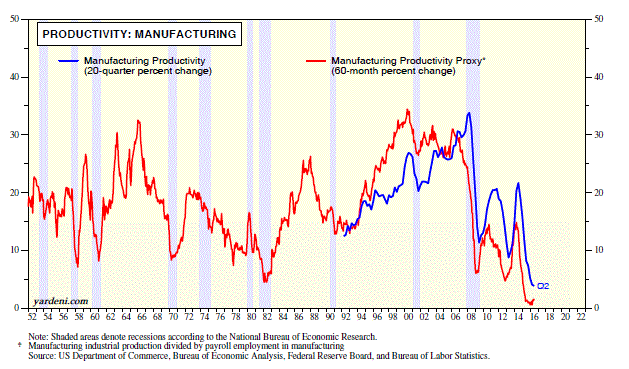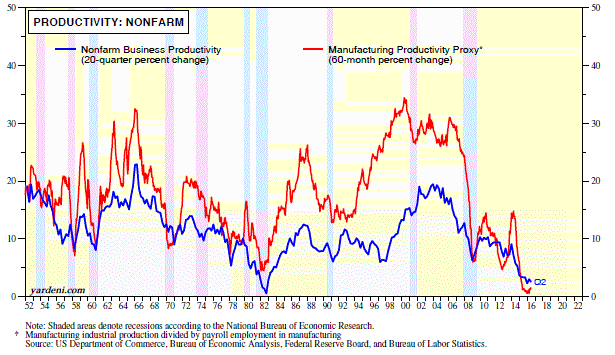
There are lots of questions raised by the weak productivity numbers that were released on Monday. Nonfarm business productivity declined 0.5% (saar) as output (1.2%) increased at a slower pace than hours worked (1.8).
That followed an unrevised 0.6% decline during Q1. On a y/y basis, productivity was down 0.4%, the first negative reading in three years. Annual revisions show productivity growth for 2015 was only 0.9% (up from 0.7%), while 2014’s was unrevised at 0.8% and 2013’s edged up 0.3% (up from zero). Those are all pathetic growth rates.
Why are companies hiring so many unproductive workers? Why aren’t they investing more to increase productivity? Why isn’t weak productivity boosting price inflation more? Why are profit margins so high if productivity is so lackluster? Could it be that output is being underestimated? Should high-tech freebies, such as free apps, be reflected in output?
If companies are using more automation, robotics, and artificial intelligence, why aren’t these technologies boosting productivity? Might the aging of the Baby Boomers explain the productivity puzzle? Are the Millennials spending too much time playing video games?
The easy answer is that output is being underestimated. The fastest-growing areas of the economy are in services, which are hard to measure. What is the output of a hospital, for example?
When I commuted to work on Wall Street from my home on Long Island, I wasted about two hours getting there and back. Now I work at my home office during those two hours thanks to the Amazon Cloud, which has dramatically lowered our IT costs and increased the reliability of our systems, requiring less IT support. Our charts are automatically updated, eliminating the need for lots of grunt work.
On the other hand, productivity in the services economy continues to lag productivity in manufacturing, which has been much easier to automate. That may be starting to change, but most of the employment gains have been in services for many years, and the lackluster pace of productivity may simply reflect that most service industries still rely on workers more than automation to deliver their services.
Another possible explanation is that, from a supply-side, companies are highly productive. The problem is that in a world of secular stagnant demand growth, their unit sales aren’t strong enough to show off their productivity. You may have the most efficient widget factory in the world, but if no one wants widgets, your productivity is zero. Consider the following:
(1) Lots of capacity. There are lots of industries and companies with too much unproductive capacity. Some have expanded too much with the help of cheap credit. Some have been disrupted by competitors using new technologies. I just can’t find too many industries that haven’t spent enough money on plant, equipment, and technology.Indeed, the industrial capacity utilization rate has dropped to 75.4% during June from a recent peak of 78.9% in November 2014. What’s puzzling is that the employment rate (which is the flip side of the official unemployment rate) has risen to 95.1% from 94.2% over this same period.
(2) Productivity cycles. While productivity growth in services has tended to lag behind that in fast-growing manufacturing, the latter is no longer fast growing. Indeed, during the current economic expansion, manufacturing productivity has been almost flat. The official manufacturing productivity data start during 1987. I have constructed a proxy for it that starts much earlier. Focusing on the long cycle in the data, I find that the 60-month growth rate is currently near zero and the weakest on record.
In the past, my manufacturing productivity proxy almost always grew significantly faster than nonfarm business productivity. During the current expansion, the two growth rates have been closer and declining in tandem. Again, it’s hard to believe that manufacturing has lost its productivity mojo. It’s possible, we suppose, that most factories are so productive that they can’t get much more so. More likely is that the demand for their products isn’t growing fast enough to boost their realized productivity. (See our new Productivity Cycles.)
(3) Margin for error. Given all of the above, why is the corporate profit margin still in record-high territory? For now, I have more questions than answers. But stay tuned, I am working on them.

